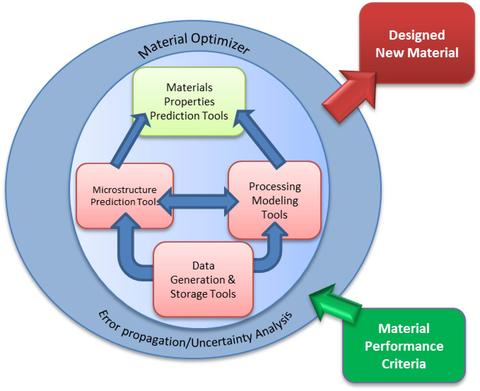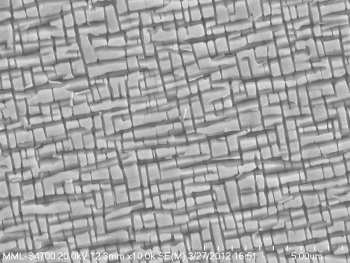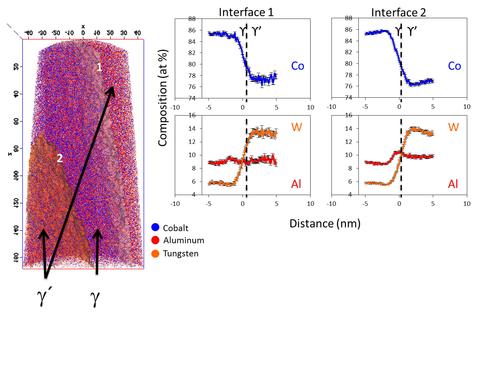Data and Computational Tools for Advanced Materials Design: Structural Materials Applications - Cobalt Based Superalloys
Summary
The development of a materials innovation infrastructure (MII) that will enable rapid and significant reductions in the development time for new materials with improved properties is a critical element of the Materials Genome Initiative (MGI). Within this infrastructure materials data and modeling tools will be integrated to optimize material properties for a given set of design criteria. Case studies will be used to determine which data structure and tools need to be implemented to facilitate efficient advanced materials design and establish standards for the MII. This project highlights a materials design approach to the design of a high temperature cobalt-based superalloys for the aerospace and power generation industries.
Currently in the aerospace industry it takes approximately 18 months to design a part, but it can take over 10 years to design the ideal material from which to make the designed part. The goal of this project is to dramatically reduce the time to design a new material for a specific application.
For the specific case study of a new class of γ/γ´ Cobalt-based superalloys, the two most important design criteria are:
- Increased homologous operating temperature (> 50 degrees higher that current Ni-based superalloys), which will increase the turbine engine efficiency and thus decrease fuel consumption and emissions.
- Increased wear resistance, which will increase the service life of the engine and lower operational costs.
Description

The advanced materials design approach for a new class of γ/γ´ Co-based superalloys is predicated on establishing the essential processing-structure-property links that are imperative for optimizing the materials chemistry and processing parameters to achieve desired materials performance objectives. Essential to this effort is the development of composition and temperature dependent functions to describe the properties of these multicomponent, multiphase materials. Composition and temperature dependent descriptions of thermodynamics, diffusion mobility, and molar volumes to describe the Co-Al-W-X (where X = Ni, Ta, Ti, Re) composition space are being developed. These composition and temperature descriptions are based on experimental and first principles data. The descriptions will be used as input into mechanistic models to predict critical material properties, including high temperature strength and creep resistance. These predictions will be verified by experiments and, if needed, the results will be used for further refinement of the databases and tools. Ultimately, these predictive models will enable determination of an alloy composition and corresponding processing and heat-treatment needed it to achieve the optimal microstructural stability, creep and wear resistance.
Major Accomplishments
Essential to the development of a new class of γ/γ′ Co-based superalloys is the stability of the γ precipitate, which is the primary strengthening mechanism for this alloy. Within the literature there are several conflicting reports on the stability of the γphase in the Co-Al-W system at the operating temperatures of interest. To correctly describe the multicomponent thermodynamics for this system, the stability and composition range for this phase needs to be determined. A series of ternary compositions were produced, heat treated, and characterized using a variety techniques to assess the stability and homogeneity range of the γ´phase. The figure below shows for the Co-0.097Al-0.108W mole fraction composition.

The desirable γ/γ′ microstructure is achieved after heat treating at 1350 ˚C for 2 h with a water quench and then aging at 900 ˚C for 1006 h followed by a water quench. X-ray diffraction measurements were used to determine the volume fraction of the γ′ present in the microstructure. As the average γ´ precipitate width is less than 1 mm, atom probe tomography (ATP) is used measure the composition of the γ´ phase. This characterization method is also able to measure the composition profile across the γ/γ´ interface. As shown below the reconstruction of two γ/γ´ interfaces and the composition profiles at the two identified interfaces. Using these characterization techniques on a series of Co-Al-W compositions the tie-line in the γ+γ´phase region was established at 900 ˚C.

This experimental information was then compared to current CALPHAD thermodynamic assessment predictions. This new experimental information will be used to improve the composition and temperature dependent thermodynamic Gibbs energy functions used by CALPHAD. The experimental information, with additional input from first principle calculations, is being used to develop composition and temperature dependent molar volume and diffusion mobility descriptions. In conjunction with the thermodynamic descriptions, the diffusion mobility and molar volume descriptions will be used as inputs into computational tools that model and optimize the microstructure evolution of the γ' precipitation.
In May 2012, the first NIST γ/γ´ Co-base superalloy workshop was held to coordinate and discuss international research efforts in this area. The 18 outside participants from industry, academia, and other government laboratories, attended the one-day workshop. Participants discussed current experimental work, how to incorporate it into current CALPHAD assessments, and what additional experimental work is needed.

